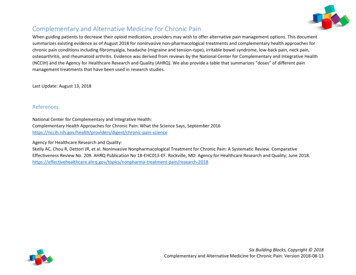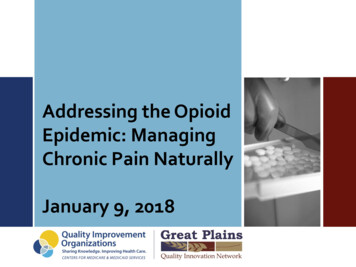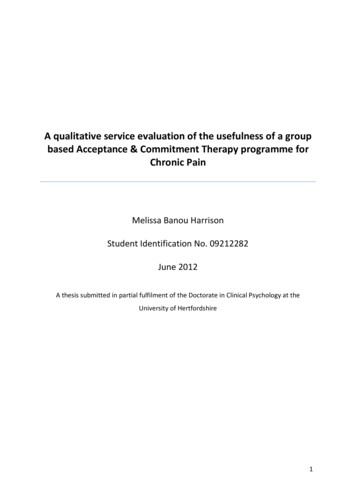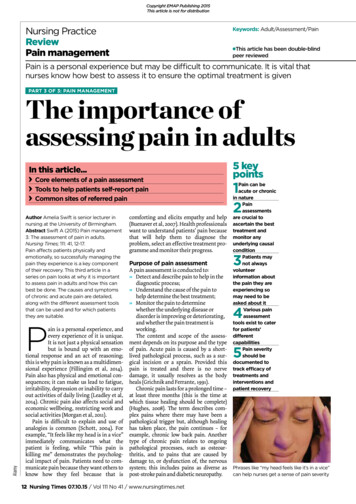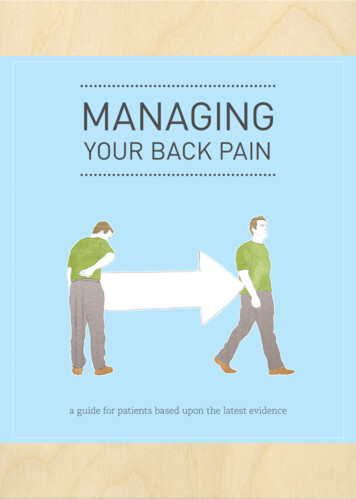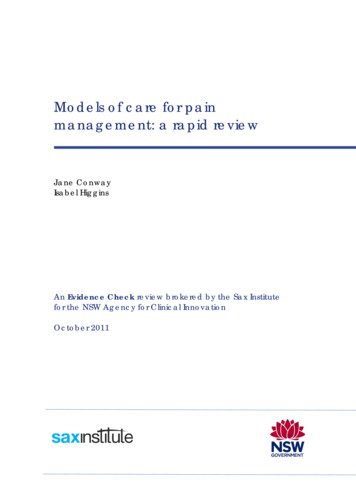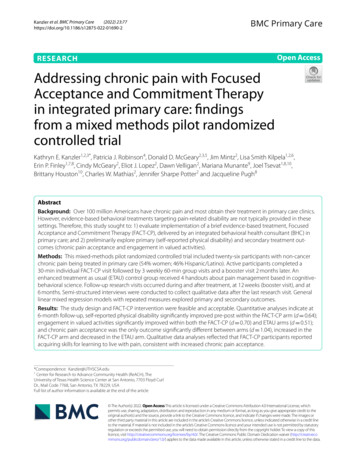
Transcription
(2022) 23:77Kanzler et al. BMC Primary Carehttps://doi.org/10.1186/s12875-022-01690-2BMC Primary CareOpen AccessRESEARCHAddressing chronic pain with FocusedAcceptance and Commitment Therapyin integrated primary care: findingsfrom a mixed methods pilot randomizedcontrolled trialKathryn E. Kanzler1,2,3*, Patricia J. Robinson4, Donald D. McGeary2,3,5, Jim Mintz2, Lisa Smith Kilpela1,2,6,Erin P. Finley1,7,8, Cindy McGeary2, Eliot J. Lopez2, Dawn Velligan2, Mariana Munante9, Joel Tsevat1,8,10,Brittany Houston10, Charles W. Mathias2, Jennifer Sharpe Potter2 and Jacqueline Pugh8AbstractBackground: Over 100 million Americans have chronic pain and most obtain their treatment in primary care clinics.However, evidence-based behavioral treatments targeting pain-related disability are not typically provided in thesesettings. Therefore, this study sought to: 1) evaluate implementation of a brief evidence-based treatment, FocusedAcceptance and Commitment Therapy (FACT-CP), delivered by an integrated behavioral health consultant (BHC) inprimary care; and 2) preliminarily explore primary (self-reported physical disability) and secondary treatment outcomes (chronic pain acceptance and engagement in valued activities).Methods: This mixed-methods pilot randomized controlled trial included twenty-six participants with non-cancerchronic pain being treated in primary care (54% women; 46% Hispanic/Latino). Active participants completed a30-min individual FACT-CP visit followed by 3 weekly 60-min group visits and a booster visit 2 months later. Anenhanced treatment as usual (ETAU) control group received 4 handouts about pain management based in cognitivebehavioral science. Follow-up research visits occurred during and after treatment, at 12 weeks (booster visit), and at6 months. Semi-structured interviews were conducted to collect qualitative data after the last research visit. Generallinear mixed regression models with repeated measures explored primary and secondary outcomes.Results: The study design and FACT-CP intervention were feasible and acceptable. Quantitative analyses indicate at6-month follow-up, self-reported physical disability significantly improved pre-post within the FACT-CP arm (d 0.64);engagement in valued activities significantly improved within both the FACT-CP (d 0.70) and ETAU arms (d 0.51);and chronic pain acceptance was the only outcome significantly different between arms (d 1.04), increased in theFACT-CP arm and decreased in the ETAU arm. Qualitative data analyses reflected that FACT-CP participants reportedacquiring skills for learning to live with pain, consistent with increased chronic pain acceptance.*Correspondence: Kanzler@UTHSCSA.edu1Center for Research to Advance Community Health (ReACH), TheUniversity of Texas Health Science Center at San Antonio, 7703 Floyd CurlDr., Mail Code 7768, San Antonio, TX 78229, USAFull list of author information is available at the end of the article The Author(s) 2022. Open Access This article is licensed under a Creative Commons Attribution 4.0 International License, whichpermits use, sharing, adaptation, distribution and reproduction in any medium or format, as long as you give appropriate credit to theoriginal author(s) and the source, provide a link to the Creative Commons licence, and indicate if changes were made. The images orother third party material in this article are included in the article’s Creative Commons licence, unless indicated otherwise in a credit lineto the material. If material is not included in the article’s Creative Commons licence and your intended use is not permitted by statutoryregulation or exceeds the permitted use, you will need to obtain permission directly from the copyright holder. To view a copy of thislicence, visit http:// creat iveco mmons. org/ licen ses/ by/4. 0/. The Creative Commons Public Domain Dedication waiver (http:// creat iveco mmons. org/ publi cdoma in/ zero/1. 0/) applies to the data made available in this article, unless otherwise stated in a credit line to the data.
Kanzler et al. BMC Primary Care(2022) 23:77Page 2 of 14Conclusion: Findings support that FACT-CP was acceptable for patients with chronic pain and feasible for delivery ina primary care setting by a BHC. Results provide preliminary evidence for improved physical functioning after FACT-CPtreatment. A larger pragmatic trial is warranted, with a design based on data gathered in this pilot.Trial registration: clinicaltrials.gov, NCT04 978961 (27/07/2021).Keywords: Chronic pain, Primary health care, Behavioral health consultation, Primary care behavioral health, Generalpractice, Mixed methods, Acceptance and commitment therapyIntroductionMost of the 100 million Americans with chronic painreceive treatment in primary care settings [1, 2]. Despiteeffective behavioral/nonpharmacologic interventions forchronic pain, patients continue to be offered primarilybiomedical treatments, [3] rather than the full range oftreatments that work [4].Delivering behavioral treatments in primary care settings improves access to care for chronic pain. The Primary Care Behavioral Health model [5–7] increasesavailability of behavioral treatments by utilizing trainedBehavioral Health Consultants (BHCs)—usually clinicalpsychologists or clinical social workers—who serve asmembers of the primary care team and deliver evidencebased nonpharmacologic treatments to patients withmedical and/or psychological concerns. BHCs draw froma variety of evidence-based treatments to deliver brief,focused interventions to improve patient functioning[8–10].One study to date examined BHC-delivered paintreatment using Brief Cognitive Behavioral Therapy forChronic Pain (Brief CBT-CP) [11] and found that patientswith musculoskeletal pain reported significantly less painintensity, fewer functional limitations and improved selfefficacy [12]. While Brief CBT-CP is promising, morenonpharmacologic treatments are needed to increaseoptions for pain treatment in primary care.Another form of CBT is Acceptance and CommitmentTherapy (“ACT”), [13] which has a strong scientific basisfor improving chronic pain outcomes [14–17]. In contrast to Brief CBT-CP and traditional CBT approaches,ACT emphasizes patient values and focuses on improving overall quality of life, eschewing traditional targets ofpain intensity and pain control [17, 18]. ACT uses a variety of experiential techniques to help patients improvetheir acceptance of chronic pain, a core component ofpsychological flexibility, involving willingness to engagein meaningful activities while in the presence of difficult experiences (i.e., unwanted physical and emotionalaspects of chronic pain) [19].Although substantial evidence for the general efficacyand effectiveness of ACT abounds, only one study hasexamined ACT for chronic pain provided in a primarycare setting [20]; study findings were promising, butthe duration of the group-based treatment protocol (16sessions) is likely to make it infeasible in many settings.However, ACT in a brief format is known as “Focused”ACT (FACT), and it may be particularly suited for delivery by BHCs due to its succinct and flexible approach[21, 22]. However, no studies have examined FACT forchronic pain delivered by BHCs in a primary care setting.Therefore, we developed a brief (5-visit) FACT forchronic pain (“FACT-CP”) -based group protocol andconducted a pilot randomized controlled trial (RCT) ina “real world” primary care setting. The objectives of thispaper are to report on findings from our study and to further describe our methods and analyses. Details of therationale, methods, and intervention are published elsewhere [23]. In preparation for a larger pragmatic trial inthe future [24, 25], the aims of this pilot study were to:1. Determine feasibility, acceptability and preliminary effectiveness of a FACT-CP treatment protocol for chronic pain delivered by a BHC in primarycare, assessing patients pre- and post-treatment (atbooster visit/12 weeks) and at 6-month follow-up.2. Explore underlying secondary outcomes, includingchronic pain acceptance and engagement in valuesbased activity, in FACT-CP participants.3. Gather qualitative data to understand experiences ofstudy participants and perceived benefits of the intervention in order to inform a larger trial and futureimplementation efforts.MethodsStudy designThis study was a mixed-methods sequential explanatory[26] pilot RCT with 6-month follow-up. The completeprotocol, including description of the study design andmethods was published prospectively [23] and registered retrospectively (27/07/2021) at ClinicalTrials.gov,#NCT04978961. All procedures were approved by theInstitutional Review Board at The University of TexasHealth Science Center at San Antonio (HSC20160512H)in accordance with federal codes for the conduct andprotection of human subjects.
Kanzler et al. BMC Primary Care(2022) 23:77Setting and participantsOur study site was a primary care clinic affiliated withThe University of Texas Health Science Center at SanAntonio using the Primary Care Behavioral Health model[7] of integrated care; the census in the clinic at the timewas approximately 6500 unique patients. The study sitehad one clinical half-time BHC and one study-fundedBHC (approximately 0.1 FTE) who conducted all of theclinical procedures detailed below. Patient inclusion criteria required (a) age 18 and older; (b) at least one noncancer pain condition persisting for 12 weeks or more; (c)a current primary care clinician at the study clinic; and(d) ongoing treatment for a non-cancer chronic pain condition. Exclusion criteria were minimized for generalizability: (a) social anxiety or unwillingness to participatein a class setting; (b) presence of symptoms of psychosisand/or delirium; (c) a medical condition or life circumstance that would contraindicate or prevent participating(e.g. upcoming surgery); and (d) inability to comprehendthe informed consent process or study instructions.RecruitmentPatients were recruited via: advertisements about thestudy posted in the clinic; referral by clinic personnel;and direct invitation based on pre-screening eligibilityidentified in the electronic health record. Recruitmentand treatment were rolling, such that participants wereenrolled as they completed pre-screening and consentprocedures. Potential participants who indicated interestwere pre-screened for eligibility by study staff then scheduled for their first visit where they completed informedconsent procedures and baseline assessments. Participants were compensated for attending assessment visits.We also held a raffle for 10 gift card at each FACT-CPgroup visit to enhance retention. FACT-CP treatmentwas provided at no cost. This study started enrollment inOctober, 2017, and 6-month follow-up assessments concluded in December, 2018; exit interviews concluded inApril, 2019.RandomizationFollowing prescreening, consent, and baseline assessment, participants were randomized to receive eitherFACT-CP or Enhanced Treatment as Usual (ETAU).Because pain severity is a factor that could affect outcomes and/or responsiveness to intervention [27], westratified to avoid misattributing effects of the intervention (i.e., type 1 error), which is especially important insmall trials [28]. At baseline, participants rated their levelof pain severity using the Numeric Rating Scale (NRS) forPain, a frequently-used single-item measure consistingof a horizontal line anchored with numeric labels (0 noPage 3 of 14pain and 10 worst possible pain). We developed 3 levelsof stratification based on clinical consensus in our teamand previously-recommended cut-points [29, 30]: 1–3(mild), 4–7 (moderate), and 8–10 (severe). Using SASsoftware (Cary, NC) we created randomized block sizesranging from 4 to 12. Varying sizes were used to balancegroups while blinding study staff/PI to assignment, withNRS score category entered into a custom web-basedapplication to facilitate and mask the randomization process (see Fig. 1 for our CONSORT diagram) [31].Data collectionSelf-report measures described below were administeredat 6 assessment visits: baseline, weeks 2, 3, 4, 12 (booster)and 24 (6-month follow-up; see Fig. 2). The studyappointed BHC was not involved in these visits and wasblind to assessment results throughout. The study BHCdid administer screening measures at each FACT-CPvisit, including the NRS, in keeping with usual practiceand standards of care in the clinic. Additional data werecollected after the 6-month assessment visit by the PI(KEK), who contacted participants via phone and conducted semi-structured “exit interviews.”InterventionsFocused Acceptance and Commitment Therapy treatmentApproximately 1 week after baseline quantitative assessment, participants in the FACT-CP arm attended a30-min individual visit with the BHC consisting of typicalinitial visit activities [7], including role clarification of theBHC; contextual interview for functional analysis of thepain problem; biopsychosocial case conceptualization;the brief FACT-CP intervention; between-visit exerciserecommendations; and collaboratively-developed goals.Over the next 3 weeks, participants attended weekly1-h group visits focused on increasing acceptance ofchronic pain towards greater psychological flexibility inresponding to and coping with chronic pain, followed bya “booster” visit approximately 2 months later [23]. TheBHC communicated with participants’ primary care clinicians throughout the course of FACT-CP care (individual BHC visit through booster visit) and kept clinicalnotes in their electronic health records, consistent withusual practice.Enhanced treatment as usualParticipants assigned to ETAU attended assessment visitswhere they completed study measures and then receiveda 1-page double-sided handout from the study researchassistant that was based on CBT principles for copingwith stress and pain (relaxation, pacing, sleep, goal-setting). Participants in both arms continued to access usual
Kanzler et al. BMC Primary Care(2022) 23:77Page 4 of 14Fig. 1 CONSORT Chart. FACT-CP: Focused Acceptance and Commitment Therapy; ETAU: Enhanced treatment as usualprimary and specialty care treatment throughout thestudy.Sample sizeRecruitment was stopped at 13 per arm, in keepingwith guidance on conducting pilot and feasibility studies [24, 25] (e.g., CONSORT [31]). We initially soughta larger sample size, however, at this stage, our teamdetermined that a smaller sample was sufficient to pilotour goals examining feasibility and acceptability of theinterventions, as well as study procedures, and to obtainpreliminary data on the effectiveness of the FACT-CPintervention.Primary outcome measures (quantitative data)FeasibilityFeasibility was evaluated using a priori establishedbenchmarks: (a) 25% participant attrition; (b) at least80% of participants rating the FACT-CP program assatisfactory as measured by response of at least 5 on a7-point Likert-scale (1 Not Satisfied at All, 7 VerySatisfied). The satisfaction question was asked in thecontext of an “exit interview”: all participants whocompleted the 6-month follow-up assessment werecontacted by the PI to provide feedback on their experiences in the study. The semi-structured phone interview lasted approximately 10 min and the quantitativedata portion included 5 Likert-scale questions to assess
Kanzler et al. BMC Primary Care(2022) 23:77Page 5 of 14Fig. 2 Treatment and research assessment visit timeline. FACT-CP: Focused Acceptance and Commitment Therapy; ETAU: Enhanced treatment asusualpatient experiences with study participation, ease ordifficulty of learning pain management skills, amountof information learned, and satisfaction with treatment.Feasibility measures also included fidelity checks ofthe study BHC. Fidelity to FACT-CP was independentlyassessed by the study’s external consultant (PR). Alltreatment visits were audiotaped. Our consultant randomly selected and listened to 22% of these visits, assessing fidelity using a standardized checklist based on theFACT-CP treatment manual. Fidelity was evidenced bygreater than 95% adherence to treatment.AcceptabilityAcceptability of the FACT-CP intervention from the participants’ perspective was measured via 3 Likert-scalequestions gathered during the semi-structured interview:perceived benefit, ease of learning about pain management, and whether the participant would recommend theFACT-CP treatment to a friend or family member.EffectivenessThe primary outcome of effectiveness was self-reportedphysical disability, assessed using the modified and psychometrically sound Oswestry Disability Index (ODI)[32]. The ODI is a 10-item self-report measure using6-point Likert scales, originally developed as a measureof back pain. We used an established modified versionthat asked about “pain” rather than “back pain” [33, 34].Scores are summed to create a total score (maximum 50)that is then divided by the highest possible score basedon items completed, then doubled to provide a percentage of disability. Reliability in our study was high (Cronbach’s alpha, α .85).Secondary outcome measuresPain acceptance was examined using the Chronic PainAcceptance Questionnaire-Revised (CPAQ) [35]. The20-item CPAQ assesses the degree to which chronicpain and related experiences influence behaviors andthe degree of effort put in to controlling pain. Itemsare responded to on a 0 to 6 Likert scale. Higher scoresindicate greater acceptance; scores range from 0 to 120.We measured engagement in values-based activity withthe Chronic Pain Values Inventory (CPVI) [36, 18], aninventory that identifies which values are important toa patient with chronic pain, and assesses the degree ofsuccess they are having in following their values. The valued domains are family, intimate relations, friends, work,health, and growth or learning. The 12-item CPVI uses6-point Likert scale questions to measure the discrepancy between ratings of importance of valued life areasand success in engaging in those life areas; lower scoresreflect greater alignment (i.e., less discrepancy) betweenvalues and actions in one’s life. The stand-alone successscale includes ratings on the engagement items only. Wechose to employ the discrepancy scale rather than thesuccess scale because we wanted to measure success inengagement in valued activities in the context of their
Kanzler et al. BMC Primary Care(2022) 23:77Page 6 of 14perceived importance. CPVI scores range from 0 to 6.Reliability was high for both the CPAQ (α .85) and theCPVI (α .82).p .520]. All data were analyzed using SPSS 26.0 [38]and/or SAS v9.4 (Cary, NC).Measures of participants’ experiences (qualitative data)We analyzed qualitative interview data using rapidqualitative analysis [39, 40]. This approach, comparedwith in-depth analyses, is particularly useful in studieswith resource constraints (i.e., a pilot study) [41] and inresearch conducted in clinical settings, to aid in timelydissemination of patient feedback [39–41]. Rapid qualitative analyses has been compared directly with more traditional thematic analysis and found to produce closelyaligned results, and is thus considered to have comparable rigor [40]. Participant responses were organizedby question (domains for both groups: Best/Most Likeable Features; Worst/Most Disliked Features; Changes inPerception of Pain; Changes in Quality of Life; and OtherFeedback). Analyses were structured to identify similarities and differences within and between groups. Interview notes were consolidated into a matrix, with rowsfor each domain and columns for individual respondents.Themes emerging within each domain and exemplarquotes were then identified by 2 co-authors who met inperson to reach consensus (KEK and EPF); 3 other independent raters (BH, LSK, CM) reviewed the table of consolidated themes and quotes via email and/or in-personreview and provided iterative feedback until consensuswas achieved [40].Qualitative data were also gathered during the exit interviews, which included open-ended questions assessing the following domains: what participants liked mostand least about their participation, and any changes inpain management or quality of life due to participation(e.g., “In what ways has your participation in our studychanged the way you think about or manage pain?”). Participants were given time to discuss anything else theywanted to share with the PI. The PI took near-verbatimcontemporaneous notes during the interviews.AnalysesAim 1 analysesWe examined acceptability and feasibility of FACTCP and study procedures by calculating percentagesand frequencies. Physical disability (primary outcome)was examined using a general linear mixed (within andbetween groups) regression model with repeated measures, controlling for baseline pain severity, with theprimary focus on comparing pre-post change in the 2study arms. Fixed effects in these statistical models weretreatment arm, time, and the treatment-by-time interaction. Although the analysis does produce conventionalANOVA-type tests, those are non-specific. Instead, thehypothesis tests were done using planned, a priori contrasts that compare the regression-based least-squaremeans to estimate change in a group using all subjects(intent-to-treat analysis), including those with missingdata. Baseline pain severity was included as a covariatebecause it was used to stratify randomization [37].Aim 2 analysesWe examined secondary outcomes, acceptance ofchronic pain (CPAQ) and engagement in values-basedactivity (CPVI) between and within groups using generallinear mixed regression models with repeated measures,again with the primary focus on comparing pre-postchange in the 2 study arms. Baseline pain severity wasagain included as a covariate.Missing data analyses.Across the 6 weeks of assessments, between 0 and15.4% of data were missing from each measure. Missingdata were handled using maximum likelihood estimation. This yields valid parameters given the usual assumption that data are missing at random. Additionally,Little’s MCAR test was non-significant for all variables,[ODI: X2 (15, N 26) 8.34, p .909; CPAQ: X2 (11,N 26) 8.13, p .702; CPVI: X2 (15, N 26) 14.08,Aim 3 qualitative analysesResultsSample characteristicsParticipants’ average age was 52 years, more than halfwere women (53%), and most identified their race aswhite (85.8%), followed by “other” (11.5%) and Asian(3.8%); Hispanic ethnicity was reported by 46.2% of theparticipants (Table 1). On average, participants had experienced chronic pain for 11.9 years, most commonly musculoskeletal pain in multiple sites (50%) or throughoutthe body (46%). There were no meaningful statistical differences between groups at baseline on demographic variables; physical disability level; or pain severity, durationor acceptance; but the ETAU group reported significantlygreater discrepancies between ratings of importanceof valued life areas and success in engaging in activities(CPVI).Primary analysesFeasibilityA priori benchmarks for feasibility were met for measures of retention, satisfaction, and fidelity. Retention inthe study was demonstrated by absence of any treatmentdrop-outs during the initial FACT-CP intervention and77% retention through the booster visit (see Fig. 1). 75%
Kanzler et al. BMC Primary Care(2022) 23:77Page 7 of 14Table 1 DemographicsFACT N 13TAU N 13TotalN 2661.5% (8)46.2% (6)53.8% (14)54 (26–79)50 (32–66)52 (26–79)GenderFemaleMean age (range)EthnicityHispanic/Latino46.2% (6)46.2% (6)46.2% (12)Non-Hispanic/Latino53.8% (7)53.8% (7)53.8% (14)White76.9% (10)92.3% (12)84.6% (22)Other15.4% (2)7.7% (1)11.5% (3)Asian7.7% (1)0.0% (0)3.8% (1)RaceMarried/living with partner84.6% (11)53.8% (7)69.2% (18)Single/divorced/widowed7.7% (1)30.8% (4)19.2% (5)In a relationship7.7% (1)15.4% (2)11.5% (3)EducationGED/High School diploma7.7% (1)23.1% (3)15.4% (4)30.8% (4)23.1% (3)27.0% (7)4-year college degree38.4% (5)30.8% (4)34.6% (9)Master’s degree23.1% (3)23.1% (3)23.0% (6)0.0% (0)7.7% (1)3.8% (1)Annual household income 10,000 10,000-20,00015.4% (2)7.7% (1)11.5% (3) 20,000– 50,00030.8% (4)53.8% (7)42.3% (11) 45,000-100,00030.8% (4)15.4% (2)23.0% (6)23.1% (3)15.4% (2)19.2% (5) 100,000Pain TypeFibromyalgia15.4% (2)7.7% (1)11.5% (3)Musculoskeletal46.1% (6)53.8% (7)50.0% (13)Multi-type23.1% (3)30.8% (4)27.0% (7)Other15.4% (2)7.7% (1)11.5% (3)Pain SiteNeck/Head15.4% (2)0.0% (0)7.7% (2)Upper Body30.8% (4)7.7% (1)19.2% (5)Lower Body7.7% (1)23.1% (3)15.4% (4)Back/Lower Back7.7% (1)15.4% (2)11.5% (3)Multi-Site/Whole BodyAcceptabilityThere were no statistically significant differences betweengroups in the 3 indicators of acceptability: perceived benefit, ease of learning, and recommendation of treatment(Table 2).Effectiveness of FACT‑CP interventionRelationship statusSome college/ Associate’sdegreeof patients reported satisfaction (rated at least 5 on the7-point scale) with the FACT-CP intervention.38.4% (5)53.8% (7)46.4% (12)Mean (SD)Mean (SD)pPain duration (years)9.72 (7.38)14.03 (13.07) 0.310Pain severity, past 2 wks (NRS)6.54 (1.90)7.08 (1.55)0.436Physical disability (ODI)38.02 (16.76) 43.57 (13.62) 0.363Pain acceptance (CPAQ)61.38 (15.08) 60.38 (18.53) 0.881Values/activities discrepancy(CPVI)1.73 (0.71)2.34 (0.77)0.045FACT Focused Acceptance and Commitment Therapy, ETAU Enhanced treatmentas usual, ODI Oswestry Disability Index, CPAQ Chronic Pain AcceptanceQuestionnaire, CPVI Chronic Pain Values Inventory (Discrepancy scale), NRSNumeric Rating Scale for Pain. No statistically significant differences were foundbetween groups on any variables except CPVIPhysical disability significantly improved in the FACT-CParm from baseline to booster visit at 12 weeks (p 0.002)with a large effect size, d 0.89, and at 6 months(p 0.023) with a medium effect size, d 0.64. The ETAUgroup also showed significant improvement from baseline to booster at 12 weeks (p 0.003) with a large effectsize, d 0.84, but the improvement was no longer significant at 6-month follow-up (p 0.546), d 0.17. Differences between groups were not statistically significantafter treatment at 12 weeks (p 0.675), d 0.16, or at6-month follow-up (p 0.196), d 0.51 (see Fig. 3 andTable 3).Exploratory analysesSecondary outcomesChronic pain acceptance Findings indicated thatchronic pain acceptance (CPAQ) increased from baseline to 12 weeks (booster) for the FACT-CP group, anddecreased for the control group, but these changes werenot statistically significant (p 0.51 and p 0.147); therewas a medium effect size for this difference, d 0.58.However, by follow-up at 6 months, the FACT-CParm had a significant increase in chronic pain acceptance from baseline (p 0.049) with medium effect size,d 0.55; and the ETAU arm experienced a significantdecrease in chronic pain acceptance (p 0.082) with amedium effect size d 0.49. This difference betweengroups was significant (p 0.009) with a large effect size,d 1.04 (see Fig. 4 and Table 3).Valued activities The discrepancy between importance and success in engaging in valued activities significantly decreased in the FACT-CP arm from pre- topost-treatment at 12 weeks (p 0.0003) with a largeeffect size, d 1.05, and at 6-month follow-up (p 0.013)with a moderate-large effect size, d 0.76. At 12-weekspost-treatment, the ETAU group also evidenced significantly decreased discrepancy scores (p 0.0009) witha large effect size, d 0.94; and at 6-month follow-up(p 0.044), with a medium effect size, d 0.51. The difference between groups in valued activities was not
Kanzler et al. BMC Primary Care(2022) 23:77Page 8 of 14Table 2 Feasibility & Acceptability RatingsFACT-CP (mean; range; SD)ETAU (mean; range; SD)Satisfaction with treatment75% (5; 1–7; 1.85)88% (5.63; 4–7; 1.19)Perceived benefit of treatment88% (5.5; 2–7; 1.6)75% (5; 1–7; 1.93)Ease of learning pain management88% (5.5, 1–7; 2)88% (5.9; 3–7; 1.64)Would recommend to others100% (6.63; 6–7; 0.52)88% (6.13; 2–7; 1.81)Anchors were 1–7 (higher scores indicate a more positive response); percentage reflects those who rated items 5; no statistically significant differences were foundbetween groupsFig. 3 Changes in Physical Disability Over Time (Primary Outcome); ODI: Oswestry Disability Index; lower scores indicate better functioningsignificant at post-treatment (p 0.63), d 0.19, or follow-up (p 0.54), d 0.24 (see Fig. 5 and Table 3).Qualitative analysis of participant experiencesThe FACT-CP participants appreciated acquiring skillsfor learning to live with pain (see Table 4). They alsoappreciated practicing mindfulness and meditation, andreceiving treatment in a small group setting. Some of theETAU participants reported that their handouts providedhelpful reminders about how to manage chronic pain.Features of the treatment that were most disliked by theFACT-CP group included the perceived small “dose” ofthe program; participants were interested in additionalmonthly classes to facilitate deeper learning and connection with others. Some ETAU participants reported thatthe handouts were ineffective in helping to manage pain.When asked about changes in thinking about or managing pain, FACT-CP participants described a changedrelationship with their pain and acquisition of different strategies for handling pain. Participants describeda more hopeful outlook after treatment, with one participant noting “there is a next chapter.” The referenceto a chapter is directly related to a metaphor and exercise used in the FACT-CP class. FACT-CP participantsdescribed positive changes in their quality of life as aresult of participating in this study, including changedperspectives on their abilities, life and pain; one participant noted, “I was able to look at things clearer.”FACT-CP participants also mentioned developing more coping skills or tools to live with pain, suchas being able to observe thoughts and not get stuck inthem (i.e., through cogn
practice, Mixed methods, Acceptance and commitment therapy. Kanzler et al. BMC Primary Care Page 3 of 14 Setting and participants Our study site was a primary care clinic aliated with e University of Texas Health Science Center at San Antonio using the Primary Care Behavioral Health model [7] of integrated care; the census in the clinic at the .

